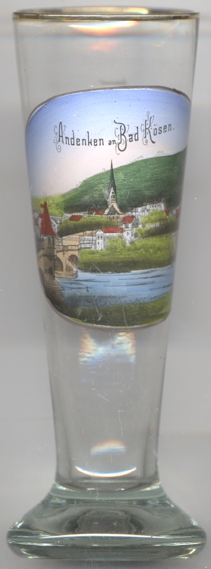

|
| DEUTSCHLAND | GERMANY |
| Bundesland: Sachsen-Anhalt | Saxony-Anhalt |
| Landkreis: Burgenlandkreis |
 Bad Kösen is situated at an elevation of 115 m on the river Saale about 7 km west of Naumburg (Saale),
the district town of the Burgenlandkreis district, about 44 km southwest of Halle (Saale), and about 110 km south of
Magdeburg, the capital of Saxony-Anhalt. Bad Kösen has a population of about 3,600 (2020) and since 2010 it is part of
the municipality of Naumburg (Saale).
Bad Kösen is situated at an elevation of 115 m on the river Saale about 7 km west of Naumburg (Saale),
the district town of the Burgenlandkreis district, about 44 km southwest of Halle (Saale), and about 110 km south of
Magdeburg, the capital of Saxony-Anhalt. Bad Kösen has a population of about 3,600 (2020) and since 2010 it is part of
the municipality of Naumburg (Saale).
The land parcel Kusenti was first mentioned in a written document in 1040; the first small settlement, Cusne, a folwark for the Pforta monastery was founded in the high Middle Ages. Up until the 18th century, rafting on the Saale river was of a certain importance for the place. Salt production, which started in 1730, became unprofitable around 1857 when salt could be produced more cheaply in Staßfurt. As a result of the decisions of the Congress of Vienna, Kösen became part of Prussia and in 1816 was assigned to the district of Naumburg in the administrative district of Merseburg in the province of Saxony, to which the town belonged until 1944. In 1868 Kösen obtained the official status of a town. In 1935, the town was recognised as a bathing resort and since then is named Bad Kösen. During the period of the German Democratic Republic, the town was successively given the epithets Volkssolbad ('People's salt bathing resort') and Bad der Werktätigen ('bathing resort of the working people'). On 1 January 2010, Bad Kösen, Janisroda, Prießnitz and Crölpa-Löbschütz were incorporated into the city of Naumburg (Saale).
The  Luther Church [left, no. 4380: background centre] is the church of the Protestant Lutheran parish
of Bad Kösen. Until 1860, the church community was assigned to the parish in Schulpforte. With the increasing bathing activity and the seasonal
influx of bathing tourists, the need for a separate place of worship grew. After Kösen became an independent municipality in 1860/1867, the new
church was finally built in 1894–1894. The architect of the Gothic revival church was Friedrich Fahro from Halle.
Luther Church [left, no. 4380: background centre] is the church of the Protestant Lutheran parish
of Bad Kösen. Until 1860, the church community was assigned to the parish in Schulpforte. With the increasing bathing activity and the seasonal
influx of bathing tourists, the need for a separate place of worship grew. After Kösen became an independent municipality in 1860/1867, the new
church was finally built in 1894–1894. The architect of the Gothic revival church was Friedrich Fahro from Halle.
[https://de.wikipedia.org/wiki/Bad_K%C3%B6sen, https://en.wikipedia.org/wiki/Bad_K%C3%B6sen;
https://de.wikipedia.org/wiki/Lutherkirche_(Bad_K%C3%B6sen)]
![[scale]](lineal.jpg)